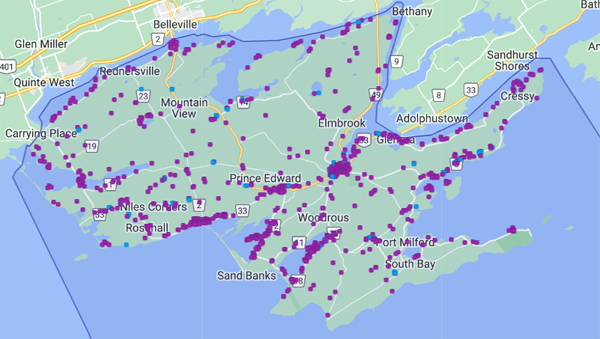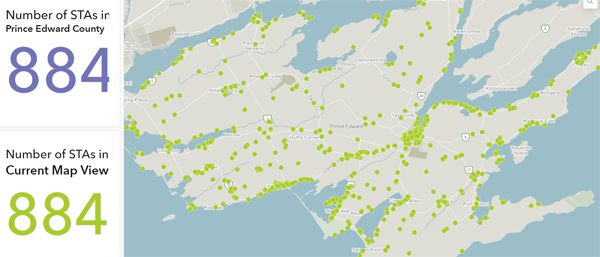County STA changes include grandfathered secondary residences, increased fines
Administrator | Aug 10, 2022 | Comments 0
A number of changes to the short-term accommodation (STA) licensing program were made by council Monday evening at a special committee of the whole meeting.
They include grandfathered secondary residence STAs only can be issued a licence or may renew a licence.
The changes also incorporate increasing fines for operating without a licence, the refusal or revocation of a licence for non-compliance, changing the definition of primary residence STA licence into two separate categories, as well as changes to commercially-zoned STAs, higher penalties for not posting a STA licence number, and reducing density requirements in hamlets.
After many hours of deliberations in what has been an on-going conversation over many months on how best the short-term accommodations (STAs) program should be managed in Prince Edward County, Monday saw council approve a number of options.
Monday’s meeting came a month after changes recommended by staff were not looked favourably upon by council.
At the July 7 special committee of the whole meeting, some of staff’s recommendations didn’t sit well with some councillors and members of the public, where a decision at that time was deferred to allow staff to take another look at the presented proposals. Six items were identified to require further investigation.
Monday’s meeting saw a deputation from the Licensed Short-Term Accommodators of Prince Edward County, together with comments from nine members of the public.
Concerns ranged from fines being too low, the need to enforce density limits on primary STAs, fines geared to number of bedrooms, as well as imposing regulations that cannot be enforced.
Others struggled with the “natural person” language for commercially-zoned STAs, and a few noted how complicated, convoluted and confusing the process had become to those in the industry.
Davelle Morrison, president of the Licensed Short-Term Accommodators of Prince Edward County, said they would like the rules enforced for those who have been operating illegally.
She noted there are more than 1,200 short-term rentals operating in the County.
The Airdna website states there are 1,226 active rentals.

“There are approximately 850 licensed STAs, when will current rules be enforced?” she asked. “We still have at least 320 unlicensed operators who have suffered no consequences.”
 The County’s map of STAs allowed to operate currently shows 884 rentals allowed to operate
The County’s map of STAs allowed to operate currently shows 884 rentals allowed to operate
In staff’s latest report, council methodically considered a number of itemized proposed changes to the STA program and related bylaws, including density provisions, reformatting the STA licensing bylaw, new definitions to the fees and charges bylaw, as well as a few housekeeping items.
Up for debate was the amount of the penalty for failure to post STA licence numbers on any STA advertisement where council considered a fine of either up to $400, or up to $4,000.
Council approved the higher fine of $4,000 for a third and subsequent offence for failure to display.
Councillor Ernie Margetson clarified with Arryn McNichol, director of corporate and legislative services, that special fines could also apply, and could go up to $50,000 in egregious cases.
Discussions over time have pointed to a lower fine being more appropriate as failure to post a licence number may simply be deemed a clerical error.
Councillor Janice Maynard was in strong support of the higher fine.
“I support the higher fine to make it an actual detriment, and not just the size of a parking ticket in the County,” said Maynard. “For a third offence, at that point, it is no longer a clerical error, it is outright ignoring the rules.”
An increase in fines for operating an STA without a licence was debated for a first offence of either up to $8,000, or up to $10,000, where the higher amount was approved. Also approved was a fine of $15,000 for a second offence, and $20,000 for a third offence.
Maynard said the first offence of the tiered system for operating without a licence of $5,000 is too low.
“I would like to see the graduated fines start at $10,000; everybody has now had plenty of opportunity and there is absolutely no excuse in this County to be operating without a licence.”
Councillor Phil St-Jean concurred.
“I believe $10,000 should be the first offence and then it escalates from there because there is no excuse for somebody not to have a licence at this point in time,” St-Jean said. “If they are, they are operating illegally and need to be shut down.”
Councillor Brad Nieman asked whether a fine that isn’t paid can be put on an individual’s tax bill to enable the municipality to get their money, to which McNichol confirmed it would be.
“We are implementing a process where after 60 days, whether it’s an unpaid fine or something unpaid related to STAs, we are going to add it on to their property taxes,” noted McNichol.
Council also agreed to refuse or revoke a licence when a licence holder does not comply with a bylaw order or zoning bylaw, contravenes maintenance and occupancy provisions, or is subject to tax arrears.
Councillor Bill McMahon asked if it was possible for someone to have a grandfathered STA which wasn’t an STA when they bought the property, thereby operating under deceitful means.
“Any grandfathered STA would have to provide grandfathered proof,” confirmed McNichol, who added a licence can be revoked if somebody has provided false information.
Councillor Jamie Forrester asked what can be done if somebody has falsified records and provided them to a municipality.
“Now they have created fraud and passed that information onto us, and I’ve heard information where people have falsified records,” Forrester said. “Can we go back and charge them with fraud?”
COA Marcia Wallace confirmed in such a case, it would be turned over to the OPP.
“We can enforce through the power of this bylaw, but ultimately if we know they have done something illegally, we can also engage with the OPP,” Wallace confirmed.
The definition of primary residence STA licence was approved to be separated into two categories, “on-site” and “off-site” where primary residence STAs apply to all or part of a dwelling to host on-site for a full calendar year, and host off-site for up to limited number of days per year.
Up for debate was the number of days to host off-site where 30 days or 60 days was considered. Agreement was reached at 45 days per calendar year.
“This situation has been brought forward to help people participate in the STA economy,” said councillor John Hirsch. “I think 60 days is necessary for it to be worthwhile for people to go through the licensing process, pay all our fees, and so on.”
Councillor Phil Prinzen asked whether 60 days was enough when the owner wasn’t residing there.
“Sixty days is sufficient given that’s basically 10 weeks of rentals,” added St-Jean.
Councillor Kate MacNaughton said you can’t go beyond 60 days.
“Anything further than 60 days, you start entering some of the problems that cause the community to demand regulation of STAs to begin with, some of the negative aspects on the whole-home rentals on neighbourhoods, etc. Also, keeping it to 60 or lower reduces some of the financial incentives.”
Emily Cowan, director of community services, programs and initiative confirmed that “host on-site” and “host off-site” primary residences, was in whole or in part where in part was up to 60 days, and whole was all year as the resident is on site.
“If it’s owner-occupied and the owner is on site, it can be rented as a primary residence STA for the entire calendar year,” clarified Cowan.” There is no limitation when the owner is present.”
Margetson further clarified that it effectively changes the use of the property from a primary to a whole-home for those 60 days.
For commercially-zoned STAs, council agreed to change the wording that “a licence can be issued to a corporation” (removing “where a natural person is that corporation’s sole shareholder, director or executive”).
“Based on what we have heard from commenters this evening, the concept of insisting that there be just a single natural person as a corporation really doesn’t apply,” said Hirsch.
Cowan explained that when the original bylaws were created in 2017/2018 there wasn’t the current housing crisis that is happening now.
“Mixed-use properties, such as residences above commercial properties can provide attainable housing and is very close to amenities,” Cowan said.
“Conversely however, allowing STAs in commercial zones helps to advance the goals of happy neighbourhoods or neighbourhood compatibility because the activity is occurring likely on a main street.”
She said they were trying to find a happy balance between helping with housing stock and trying to ensure people aren’t able to own a multitude of secondary residence STAs, noting there were far fewer commercial zones where that was possible.
Further, Cowan noted if council approved the continuance of secondary residence STA licences, the provisions includes one licence per person, or per corporation.
MacNaughton said she can’t support a licence being issued to a corporation.
“Dwellings above commercial properties typically provide an excellent source of affordable housing for long-term rental units,” said MacNaughton. “As this is still a viable use for dwellings on commercial properties, a natural person is the right direction and there are alternatives for corporate owners.”
Maynard also was not in support of a licence being issued to a corporation.
“What we don’t want to see happen is corporations with multiple shareholders buying up our valuable commercial properties because they can now make more money on them as an STA, more than a traditional commercial enterprise,” she said.
Planner James Griffin confirmed you have to have a commercial use to have a permitted dwelling unit, even if it hasn’t been committed to commercial yet.
Up next, council approved that grandfathered secondary residence STAs only may be issued a licence or may renew a licence. Rejected was the option that secondary residence STA licences continue to be provided, with provisions.
“I see this as the only choice we can undertake, we should not be looking to incentivize second home purchasing with financial incentives,” said MacNaughton.
Councillor Stewart Bailey agreed. “This is where we started, this is what we are looking for,” he said.
Councillors Hirsch and Prinzen disagreed.
COA Wallace stated that every application received, including those in process and the 74 applications that were never processed due to the pause in the STA licensing program, all of those will be treated as potentially grandfathered.
“They will all go through the process and be evaluated under our current rules to be considered and moved through the process, but nothing new as of next Tuesday when council ratify.”
Wallace further commented that by choosing this option, there is a subsequent official plan amendment and zoning that will need to be made. She noted the municipality have not been entertaining OP amendments under the official plan, but said they can be done if municipality initiated.
Because it requires public notice, Wallace said it will either have to go to the September meeting or the November meeting and will be the last chance for this council to legally change the planning instruments that refer to secondary or whole homes.
“We will change it so that it reflects a grandfathered right, but nothing else and that requires both a change to the OP and the zoning.”
Wallace confirmed this particular agenda item would therefore not be ratified next Tuesday because it requires a public meeting.
Resulting was a suggestion by councillor Bill Roberts for reconsideration of the vote just made on the grandfathered secondary residence STAs decision.
A recorded vote on the reconsideration failed, meaning this item will return to the planning meeting of Sept. 7 (to be ratified Sept. 13).
The final item on the agenda relates to density requirements where council approved amending the zoning bylaw to reduce the radius to 120 metres (from 220 metres presently) when calculating density for hamlet residential zoned properties.
Rejected was the option to maintain the existing density requirements, but interpret density calculation to include both secondary and primary residences in the numerator of the calculation.
The decisions are expected to be on the agenda for council ratification at the Aug. 16 council meeting. The exception being the grandfathered secondary residence STAs decision which will come before the planning committee meeting on Sept. 7.
Filed Under: Featured Articles
About the Author:
































